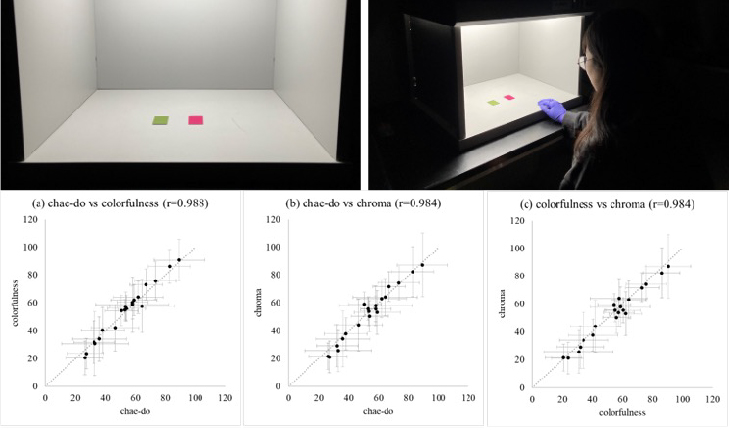
In this study, the relationships between chae-do, the commonly used Korean terminology to describe chromatic attributes, CIE definition for colorfulness, Munsell definition for chroma, Berns’ definition for CIELAB based vividness and depth are investigated. Although only the definitions were presented, without corresponding terminologies, the observers’ responses showed that chae-do is understood very similarly to the definitions of CIE colorfulness and Munsell chroma. Responses for the definitions of vividness and depth also showed high correlation with Berns’ CIELAB based vividness and depth predictions, which shows that definitions were well understood. No correlations were found between the definition of CIE colorfulness and the definition of vividness, which shows that the definition of vividness is understood differently to the definition of colorfulness. Comparing the response with color appearance model predictions, the responses showed good correlation with the predictions. Especially, colorfulness definition responses showed the highest coefficient correlation with CIELAB-based Berns’ depth prediction, implying the possibility of colorfulness predictor modification for better prediction. The findings can be further investigated to observers from other non-English speaking countries and collect meaningful cross-cultural color appearance data.

Accurately describing the effect of lighting on color appearance phenomena is critical for color science education. While it is ideal to conduct in-person tutorials to demonstrate the color appearance fundamentals, laboratory tutorials have been limited due to COVID-19. The limitation of in-person gatherings and the increase popularity of remote teaching help evoke alternative methods to demonstrate color appearance phenomena. Here, a remote tutorial method is described, and results are compared to in-person tutorials. While the remote tutorial had weaker result in representing observers' color experience compared to the in-person lab tutorial, remote demonstrations can be used to demonstrate and discuss the limitations of color imaging, and the difference between the human visual system and digital imaging systems.